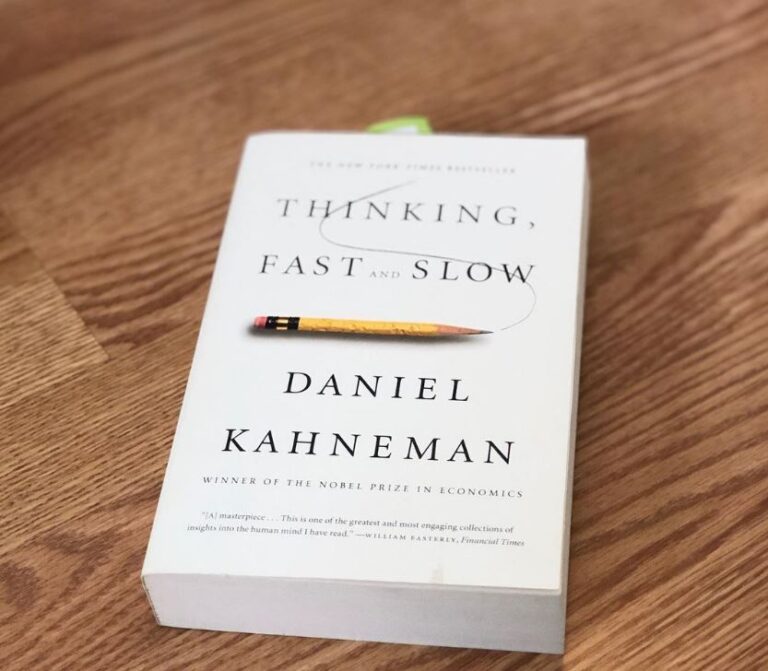Insights of Daniel Kahneman’s groundbreaking work, “Thinking, Fast and Slow”
In a world driven by quick judgments and hasty actions, understanding the inner workings of our mind has never been more critical. Join us on an awe-inspiring journey into the depths of cognitive wellness, where we delve into the remarkable insights of Daniel Kahneman’s groundbreaking work, “Thinking, Fast and Slow“. Embark with us as we explore the biases and heuristics that shape our decisions, ultimately empowering you to make more informed choices in your own life.
Step into the realm of System 1 and System 2, the twin engines of human cognition.
The first, System 1, is the instinctive and intuitive part of our mind, guiding us effortlessly through everyday life.
Its counterpart, System 2, is the deliberative and analytical force that requires conscious effort.
By understanding the delicate interplay between these systems, we can harness their potential and unlock the secrets to elevated decision-making.
Discover the influence of anchoring bias, where the first piece of information encountered can dramatically sway our decisions. As we question initial anchors, we gain a unique perspective on situations and break the shackles of preconceived notions.
“It’s about consciously detaching from those initial reference points,” explains cognitive psychologist “and allowing our minds to breathe and explore new possibilities”
Loss aversion, another fascinating aspect of human behavior, shapes the choices we make. Inclined to fear losses more than we value gains, understanding this emotional bias empowers us to embrace calculated risks and embark on a path of personal growth. By mitigating the fear of loss, we open doors to new opportunities and begin to align our actions with our true desires.
Time, costs, and risks of future actions
As the journey unfolds, we confront the planning fallacy, a bias that urges us to underestimate the time, costs, and risks of future actions. Kahneman warns us against unwarranted optimism, urging a realistic assessment of plans to avoid unexpected hurdles. Combining healthy skepticism with careful consideration allows us to navigate the complexities of life more effectively.
Take a step back
One of the most intriguing insights lies within the availability heuristic, a mental shortcut that can sometimes lead us astray. By taking a step back and critically evaluating information accessibility, we gain a deeper understanding of the facts and make more informed choices. Expanding our perspective enriches our assessments and offers a more comprehensive comprehension of the situations we encounter.
Prospect theory
A seminal concept explored in Kahneman’s work is prospect theory, which challenges traditional economic models and reveals how individuals evaluate potential outcomes. By recognizing our nonlinear perception of gains and losses, we gain a deeper understanding of risk and reward. This illuminating awareness equips us with the tools to make decisions that align more closely with our values and aspirations.
Overconfidence ?
Our confidence can often hinder accurate judgment, leading to overconfidence. By recalibrating our confidence levels, we cultivate humility and a more realistic self-assessment. Acknowledging the limits of our knowledge allows for a deeper understanding of our capabilities and fosters a more accurate decision-making process.
Reflecting on past
Reflecting on past events, hindsight bias often distorts our perception, hindering our progress. However, by understanding the intricacy of forecasts and avoiding the draw of retrospect certainty, we develop a mindset that emphasizes ongoing learning and adaptation. Drawn from Kahneman’s analysis of this bias, we can cultivate an attitude that prioritizes growth over stagnation.
Sunk cost fallacy
An irrational commitment to past investments, known as the sunk cost fallacy, can hinder our ability to make sound choices. By evaluating decisions based on future benefits rather than past investments, we liberate ourselves from unproductive endeavors. Aligning our choices with our current goals and priorities propels us towards a brighter future.
System 2
The key to unlocking cognitive wellness lies in systematic thinking. By engaging our analytical System 2 and consciously mitigating biases, we develop the mental fortitude needed to approach decisions with clarity and objectivity. Embracing systematic thinking propels us towards a more rational approach to life and empowers us to overcome the snares of intuitive judgments.
In the timeless work of “Thinking, Fast and Slow,” Daniel Kahneman reveals the nexus of the human mind and the power it holds over our decision-making. This indispensable exploration of cognitive processes equips us with the tools needed to navigate life’s choices mindfully. By fostering a deeper understanding of our cognitive mechanisms, we unleash the transformative potential within ourselves.






